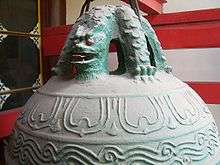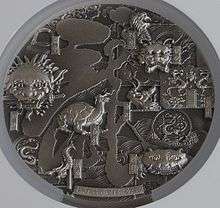Nine sons of the dragon
The nine sons of the dragon are Chinese dragons who are the mythological sons of the Dragon King. There are many variations in the different descriptions of the nine sons, including in basic facts like their names, but all versions state that there are nine.

History
The oldest known attestation of the children of the dragon list is found in the Shuyuan zaji (菽園雜記, Miscellaneous records from the bean garden) by Lu Rong (1436–1494); however, he noted that the list enumerates mere synonyms of various antiques, not children of a dragon.[1]
Several Ming Dynasty texts list what were claimed as the Nine Offspring of the Dragon (Chinese: 龍生九子; pinyin: Lóng shēng jiǔzǐ), and subsequently these feature prominently in popular Chinese stories and writings. de Visser (1913, pp. 101–102), quoting Xie Zhaozhe (謝肇淛, 1567–1624) in his work Wu Za Zu (五雜俎, ca. 1592) gives the following listing in order of oldest to youngest:
A well-known work of the end of the sixteenth century, the Wuzazu 五雜俎, informs us about the nine different young of the dragon, whose shapes are used as ornaments according to their nature.
- The qiú niú 囚牛, (Form of dragon) a creature that likes music, are used to adorn musical instruments.
- The yá zì 睚眦, (Hybrid of wolf and dragon) a creature that likes to fight, is aggressive and is normally found on cross-guards on sword as ornaments.
- The cháo fēng 嘲風, (Resemble a Phoenix and dragon) a creature that likes to adventure. They are typically placed on the four corners of roofs.
- The pú láo 蒲牢, (Four leg small form dragon class) a creature that likes to scream, and are represented on the tops of bells, used as handles.
- The suān ní 狻猊, (Hybrid of lion and dragon) a creature that likes to sit down, are represented upon the bases of Buddhist idols (under the Buddhas' or Bodhisattvas' feet).
- The bì xì 贔屭, also known as bà xià 霸下 (Hybrid of turtle and dragon) a creature with a large shell able to carry heavy objects, and are normally found on under grave-monuments.
- The bì àn 狴犴, (Hybrid of tiger and dragon) a creature that likes litigation, are placed over prison gates (in order to keep guard).
- The bā xià 霸下, (Hybrid of reptilia animal and dragon) a creature that likes to drink water, and is typically used on bridge structures.
- The chī wěn 蚩吻, (Hybrid of fish and dragon) a creature that likes swallowing, are placed on both ends of the ridgepoles of roofs (to swallow all evil influences).
Further, the same author enumerates nine other kinds of dragons, which used as ornamental decoration or as part of classical Chinese architecture. These examples can be found architecture throughout Asia used for adorning key-holes, on roofing, incense burners, door knockers, bridges, etc.
The Sheng'an waiji (升庵外集) collection by the poet Yang Shen (楊慎, 1488–1559) gives different 5th and 9th names for the dragon's nine children: the tāo tiè (饕餮), form of beasts, which loves to eat and is found on food-related wares, and the jiāo tú (椒圖), which looks like a conch or clam, does not like to be disturbed, and is used on the front door or the doorstep. Yang's list is bì xì, chī wěn or cháo fēng, pú láo, bì àn, tāo tiè, qiú niú, yá zì, suān ní, and jiāo tú. In addition, there are some sayings including xì xì (屓屭); which have the shape of the chī hǔ (螭虎 One kind small form dragon), and are fond of literature, are represented on the sides of grave-monuments.[2]
Modern names

The 9 sons of the dragon were recognized by the Chinese government's official Shanghai Mint in 2012's year of the Dragon by issuing 2 sets of coins, one in silver[3] and one in brass.[4] Each coin in the 9 coin sets depicts one of the 9 sons. A 10th additional coin was issued depicting the father dragon in silver[5] and brass,[6] which has iconography of the 9 sons on the reverse, for a total of 20 coins in the series.[7] The coins are certified by NGC with the following names:
Number nine
The number nine is special in China as it is the largest possible single digit, and Chinese dragons are frequently connected with it. For example, a Chinese dragon is normally described in terms of nine attributes and usually has 117 (9x13) scales - 81 (9x9) Yang and 36 (9x4) Yin. This is also why there are nine forms of the dragon and there are 9 sons of the dragon. The Nine-Dragon Wall is a spirit wall with images of nine different dragons, and is found in imperial Chinese palaces and gardens. Because nine was considered the number of the emperor, only the most senior officials were allowed to wear nine dragons on their robes — and then only with the robe completely covered with surcoats. Lower-ranking officials had eight or five dragons on their robes, again covered with surcoats; even the emperor himself wore his dragon robe with one of its nine dragons hidden from view.
There are many places in China with the phrase "Nine Dragons" in their name, the most famous being Kowloon (in Cantonese) in Hong Kong. The part of the Mekong in Vietnam is known as Cửu Long, with the same meaning.
See also
- Chi (mythology)
- Chinese dragon
- Chinese mythology
- Chinese gods
- Dragon King
- King of the Gods
- List of deities
References
- Yang Jingrong & Liu Zhixiong (2008), quoting Lu Rong. 菽園雜記 [Miscellaneous records from the bean garden].
- 吾三省 (Wu Sanxing) (2006), 中國文化背景八千詞 [Eight thousand words and expressions viewed against the background of Chinese culture] (in Chinese), Hong Kong: 商務印書館 (Commercial Press), p. 345, ISBN 962-07-1846-1
- CCT3564: 2012 7.5 oz silver lunar dragon 9 sons of the dragon 9 coin set
- CCT4055: 2012 brass lunar dragon 9 sons of the dragon 9 coin set
- CCT3563: 2012 600 g silver lunar dragon 9 sons of the dragon father dragon
- CCT3610: 2012 brass lunar dragon 9 sons of the dragon father dragon
- CCT4243: 2012 lunar dragon 9 sons of the dragon 20 coin set Archived 2016-03-04 at the Wayback Machine
- CCT3606: 2012 7.5 oz silver lunar dragon 9 sons of the dragon Bi An
- CCT3607: 2012 7.5 oz silver lunar dragon 9 sons of the dragon Bi Xi
- CCT3603: 2012 7.5 oz silver lunar dragon 9 sons of the dragon Chao Feng
- CCT3609: 2012 7.5 oz silver lunar dragon 9 sons of the dragon Chi Wen
- CCT3608: 2012 7.5 oz silver lunar dragon 9 sons of the dragon Fu Xi (Xi Xi)
- CCT3602: 2012 7.5 oz silver lunar dragon 9 sons of the dragon Pu Lao
- CCT3598: 2012 7.5 oz silver lunar dragon 9 sons of the dragon Qiu Niu
- CCT3604: 2012 7.5 oz silver lunar dragon 9 sons of the dragon Suan Ni
- CCT3605: 2012 7.5 oz silver lunar dragon 9 sons of the dragon Ya Zi
- de Visser, Marinus Willem (1913). Dragon in China and Japan.CS1 maint: ref=harv (link)
- 杨静荣 (Yang Jirong); 刘志雄 (Liu Zhixiong) (2008). 龙的繁衍与附会——龙生九子 [Dragon's derived and associated creatures: The nine children of the dragon]. 龙之源 [The Origin of the Dragon]. 中国书店. ISBN 7-80663-551-3.
External links
| Wikimedia Commons has media related to Nine dragons. |